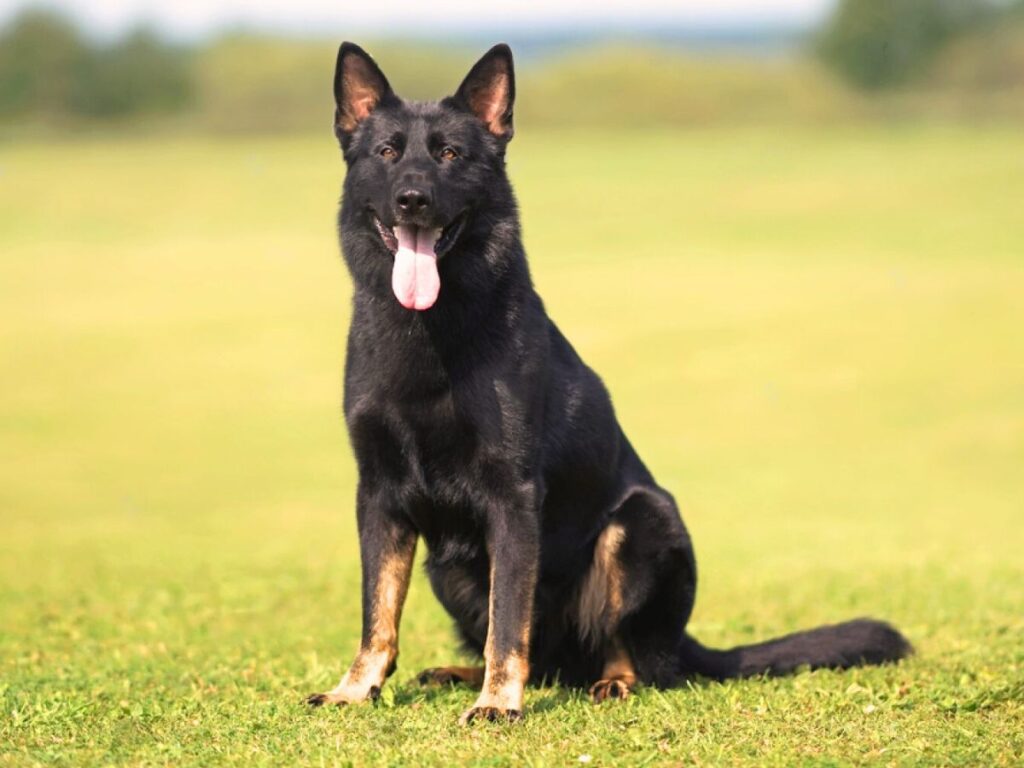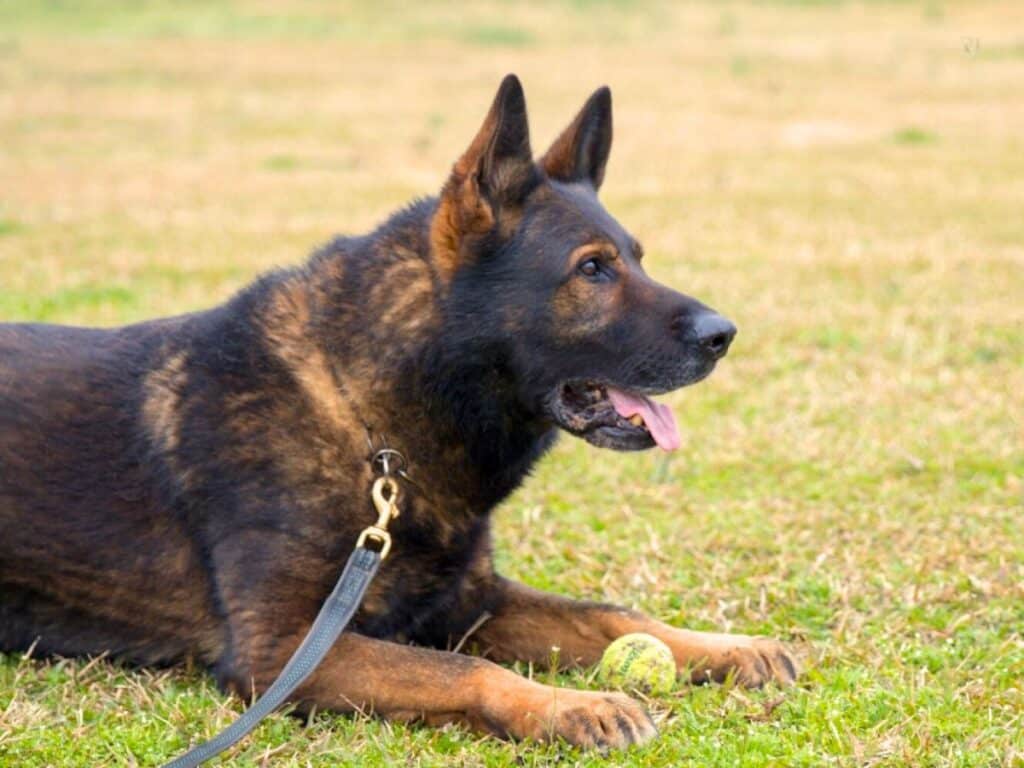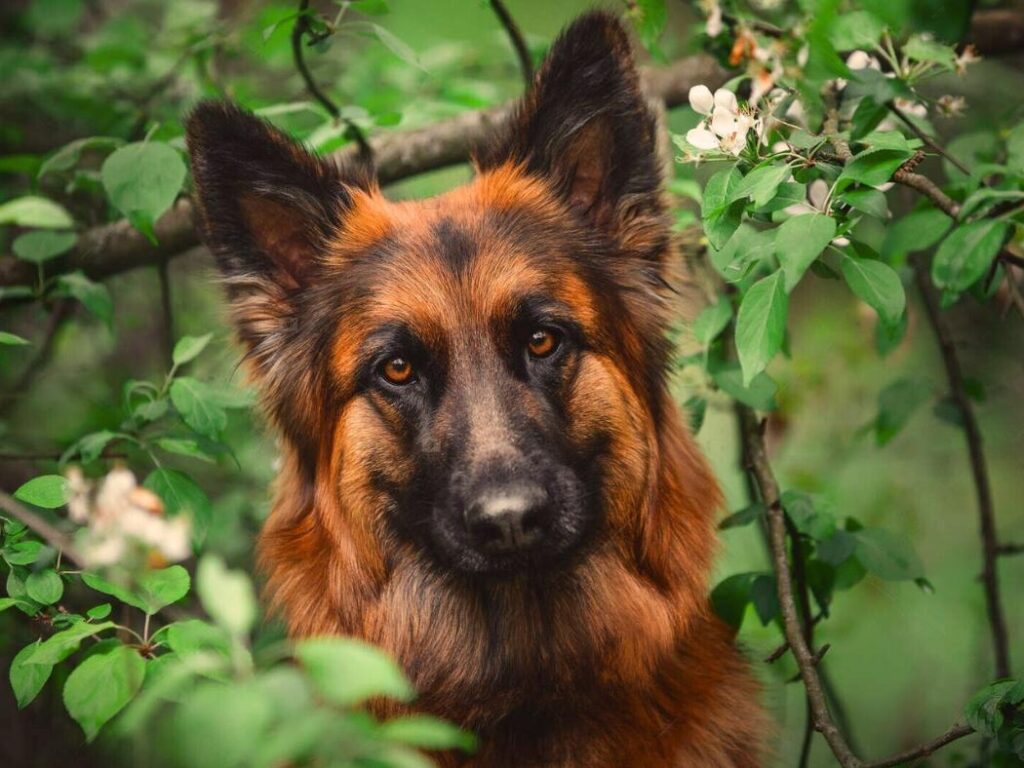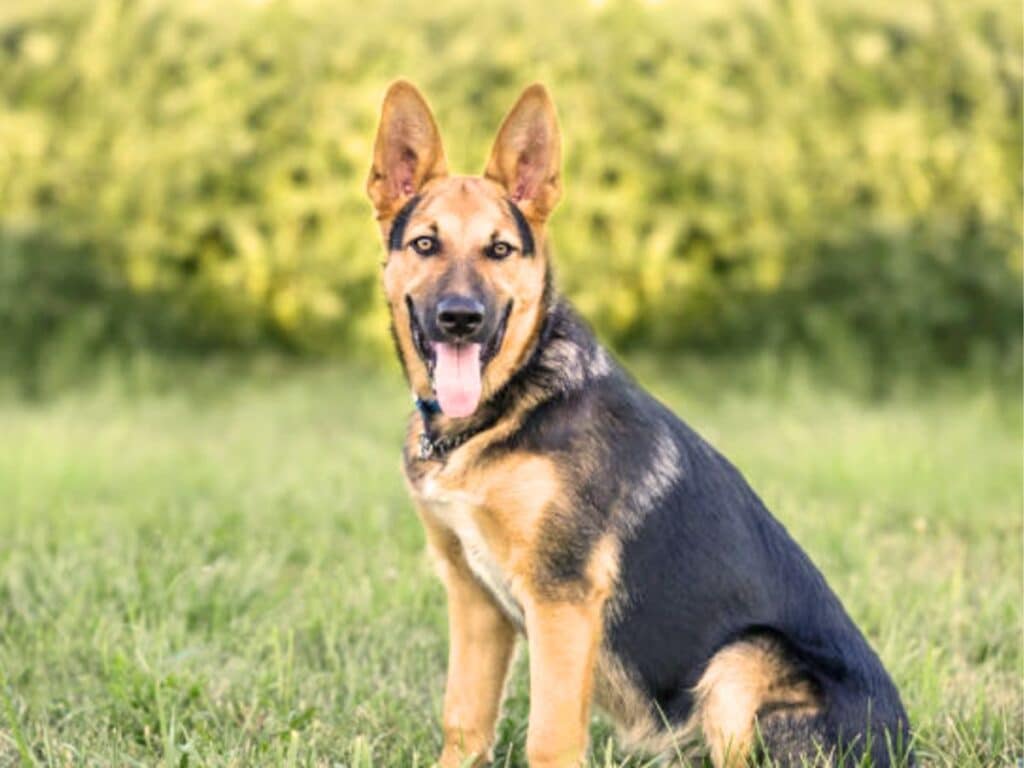Bi-color German Shepherds are a unique and fascinating variation of the German Shepherd breed.
These dogs are characterized by having two distinct colors, usually black and tan/red.
Bi-Color German Shepherds have a striking appearance, with their unique coat pattern that sets them apart from other German Shepherd types.
In this article, we will delve into the world of these German shepherd dogs, exploring their origins, characteristics, temperament, and what makes them stand out from the rest.
What is a Bi-Color German Shepherd?

Distinctive Characteristics of Bi-Color German Shepherds
Black and tan are the most common German Shepherd colors. However, some people prefer a different color variation – the bi-color German Shepherd.
This breed is characterized by its black coat with brown or tan markings. The black coloration is inherited from the Black German Shepherd.
Bi-Color German Shepherds have a solid black coat with distinct brown or tan markings on their legs, chest, eyebrows, and face.
These markings can vary in size and shape, but they typically cover about 20% of the dog’s body.
The American Kennel Club (AKC) recognizes Bi-Color German Shepherds as an official breed variation.
They are also recognized by other breed organizations around the world. This recognition has helped to increase their popularity among dog lovers and breeders alike.
The Popularity of Bi-Color German Shepherds
Bi-Color German Shepherds have become increasingly popular over the years due to their unique appearance and temperament.
Many people find them to be more visually appealing than traditional black and tan German Shepherds.
They are known for being loyal, intelligent, and protective dogs that make great companions for families.
One reason why Bi-Color German Shepherds have gained popularity is because they are less common than other breeds.
This makes them more exclusive and desirable to own. Breeders often charge a premium price for these dogs due to their rarity.
Another factor contributing to their popularity is social media.
Many owners share photos of their Bi-Color German Shepherds on platforms like Instagram and Facebook, which helps to spread awareness of this breed variation.
Check out this selection of handpicked essentials for your German Shepherd on my Amazon store – Click Here!
Causes of a Bi-Colored Coat

Recessive Gene: The Main Cause of Bi-Color Coat
So what exactly causes this unique color pattern in these dogs? The answer lies in genetics.
A recessive gene is responsible for the bi-color coat in German Shepherds.
This means that both parents must carry the gene to produce offspring with a bi-color coat.
While it may seem simple enough, understanding genetics can be complex.
In order to produce a bi-color puppy, both parents must have at least one copy of the recessive gene.
If only one parent has the gene, there is a chance that some puppies in the litter will have a bi-color coat while others will not. It all comes down to probability and chance.
Variations in Tan Markings
Although all bi-color German Shepherds have black coats with tan markings, the amount and placement of these markings can vary from dog to dog.
Some dogs may have more extensive tan markings on their chest, legs or face than others.
Others may have less noticeable markings that are limited to specific areas such as their paws or eyebrows.
The variation in tan markings can also depend on other factors such as age, health, and diet.
For example, an older dog may start to lose pigmentation in their fur which could cause changes in their overall coloring including their tan markings.
Not a Fault in Breed Standard
Despite variations in marking patterns and color intensity, it’s important to note that having a bi-color coat is not considered a fault according to breed standards set forth by major kennel clubs such as AKC or UKC (United Kennel Club).
In fact, many people find this unique coloration quite desirable.
Cost of a Bi-Colored GSD Puppy

Factors Affecting the Cost of a Bi-Colored GSD Puppy
The cost of a bi-colored German Shepherd puppy can vary depending on several factors. One of the most significant factors is the breeder’s reputation and location.
Reputable breeders who have invested in breeding programs, health testing, and genetic screening may charge higher prices for their puppies.
The region where the breeder is located can also affect the price, as some areas have higher costs of living than others.
Another factor that affects the cost of a bi-colored GSD puppy is its bloodline.
Puppies from champion bloodlines or those with excellent pedigrees may command higher prices than those without such lineage.
Puppies with unique color patterns or rare coat types may also be more expensive.
Age, gender, and health condition are other factors that can influence the price of a bi-colored GSD puppy.
Younger puppies are generally more expensive than older ones because they require more care and attention from breeders.
Female puppies may also be pricier than males due to their potential breeding capabilities.
Additional Fees for Services
In addition to the base price of a bi-colored GSD puppy, some breeders may charge extra fees for additional services such as vaccinations, microchipping, and deworming.
These fees can add up quickly and significantly increase the overall cost of purchasing a puppy.
Adopting From Shelters or Rescues
For those looking to adopt rather than buy a bi-colored GSD puppy, shelters or rescues can be an affordable option.
Adoption fees typically range from $50-$500 depending on location and organization.
While adopting a German Shepherd from shelters or rescues may be more cost-effective, it is essential to note that the puppies may not come from reputable breeders.
Their health history and genetic background may be unknown, which could lead to potential health issues down the line.
RELATED: How To Rescue a German Shepherd
Here’s a video of highly trained bi-color German Shepherds in action…
AKC Breed Standard for German Shepherds
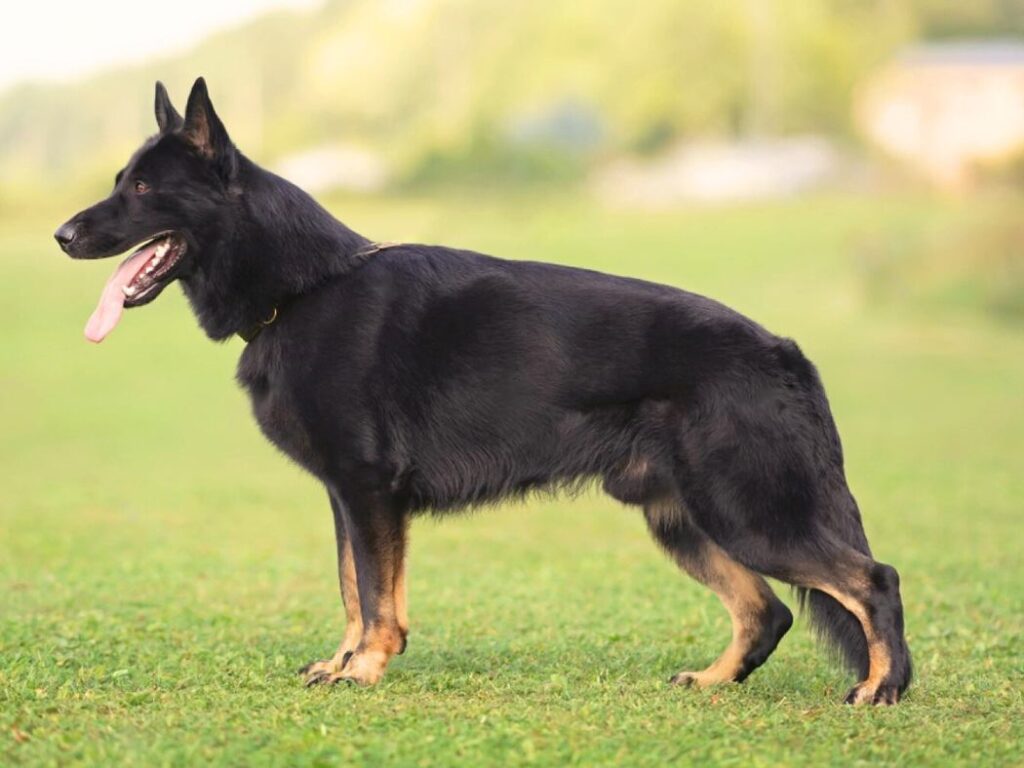
The AKC has a detailed breed standard for German Shepherds, which outlines the ideal physical characteristics and temperament of the breed.
According to the AKC, German Shepherds should be “a medium-sized, well-proportioned, muscular dog with a slightly elongated body.”
They should also have a distinct gait and be able to move with agility and grace.
In terms of coloration, the AKC allows for several different colors in German Shepherds. (Source)
These include black and tan, black and red, black and cream, solid black or sable. Bi-colors are also allowed as long as they meet all other physical requirements outlined in the standard.
Eligibility for Registration
One of the main benefits of having an AKC-registered dog is that it can participate in various events and shows hosted by the organization.
To be eligible for registration with AKC, a dog must meet certain criteria such as being purebred and having proper documentation.
Bi-colored German Shepherds are not excluded from eligibility for registration with AKC based on their coloration alone.
As long as they meet all other requirements outlined by the organization, they can be registered just like any other colored German Shepherd.
Competing in Shows
German Shepherds are a popular breed in temperament and overall health.
Bi-colored German Shepherds are allowed to compete in AKC shows as long as they are registered with the organization.
In fact, there have been several bi-colored German Shepherds that have excelled in various AKC events over the years.
For example, a bi-colored German Shepherd named “Buddy” won the Herding Group at the Westminster Kennel Club Dog Show in 2019.
Also read:
- DDR German Shepherd: Working Dog with a Fascinating History
- American Tundra Shepherd: A Fascinating and Unique Breed
Bi-Color vs Solid Color German Shepherds

Distinct Characteristics
Bi-color German Shepherds have a unique coat pattern that consists of two colors, usually black and brown.
Black is the dominant gene in German Shepherds, which means that solid black German Shepherds are more common than bi-color ones.
Bi-color German Shepherds have a higher percentage of brown color in their coat, while solid black German Shepherds have no brown at all.
Solid black German Shepherds are known to be more dominant compared to bi-color ones.
This can make them better suited for certain tasks such as protection or police work.
On the other hand, bi-color German Shepherds tend to be more laid back and easy-going.
Appearance Differences Between Bi-Color and Solid-Color German Shepherds
Bi-color and solid-color German Shepherds also differ in appearance.
Bi-color German Shepherds often have a distinct “saddle” pattern on their back where the brown coloring is concentrated.
They may also have brown markings on their face and legs.
Solid black German Shepherds, as their name suggests, are completely black with no other colors present in their fur.
They may have some white markings on their chest or toes but these are not considered part of the breed standard.
Personality Differences
While both bi-color and solid-color German Shepherds make great pets, it’s important to consider your lifestyle and needs before choosing a specific variation based on personality differences.
Solid black German Shepherds tend to be more dominant compared to bi-color ones.
This can make them better suited for certain tasks such as protection or police work.
They are also known to be more territorial and protective of their owners.
Bi-color German Shepherds, on the other hand, are often described as friendly and approachable.
This makes them great family pets that get along well with children and other animals.
Similarities Between Bi-Color and Solid-Color German Shepherds
Despite their differences in appearance and personality, bi-color and solid-color German Shepherds share many similarities. Both variations are intelligent, loyal, and trainable.
They require a lot of exercise and mental stimulation to stay healthy and happy.
Both bi-color and solid-color German Shepherds have a strong work ethic which makes them great candidates for various jobs such as search-and-rescue dogs, therapy dogs, or service dogs for people with disabilities.
Training and Care for Bi-Color German Shepherds

Regular Exercise and Training for Physical and Mental Health
Bi-color German Shepherds, like all other colored German Shepherds, require regular exercise and training to maintain their physical and mental health.
These dogs are highly intelligent, energetic, and active. They need at least 30 minutes of moderate exercise daily to stay healthy.
Regular exercise helps reduce stress levels in dogs, keeps them mentally stimulated, and prevents obesity.
It is also essential to provide them with a safe space where they can run around freely without any restrictions.
Understanding the Specific Needs of Bi-Color German Shepherds
Bi-color German Shepherds may have different temperaments compared to other colored German Shepherds.
Therefore it’s important to research and understand their specific needs before bringing one home.
These dogs are loyal, protective, intelligent, confident, and fearless.
They make excellent family pets but require early socialization with people and other animals to prevent aggression towards strangers or unfamiliar situations.
Training for Various Tasks
Bi-color German Shepherds are highly trainable dogs that excel in various tasks such as search-and-rescue operations, police work, service animals for people with disabilities, or medical conditions such as seizures or diabetes alert dogs.
These tasks require specialized training from an experienced trainer who understands the breed’s unique characteristics.
Proper Care Tips
While bi-color German Shepherds are a unique and beautiful breed, it’s important to remember that they are still dogs and require proper care and attention like any other breed.
Regular grooming is essential to keep their coat healthy and shiny.
They shed heavily twice a year, so brushing them daily during these periods helps reduce shedding.
It’s also essential to provide them with high-quality food that meets their nutritional needs.
Are Bi Colored German Shepherds Rare?
Bi-color German Shepherds are not as common as the traditional black and tan or sable variations, but they are not considered rare either.
Bi-color German Shepherds have a black coat with distinctive tan markings on the legs, chest, and face.
While some bi-color German Shepherds may have more tan markings than others, the black and tan contrast is always present.
The rarest of the German shepherd colors are solid white, solid blue, solid red, and solid grey color.
While the popularity of bi-color German Shepherd dogs has increased in recent years, they are still not as common as other color variations.
However, their unique and striking appearance, coupled with their intelligence, loyalty, and trainability, make them a desirable choice for many dog owners.
Can two black & tan GSD parents produce a bi-color pup?
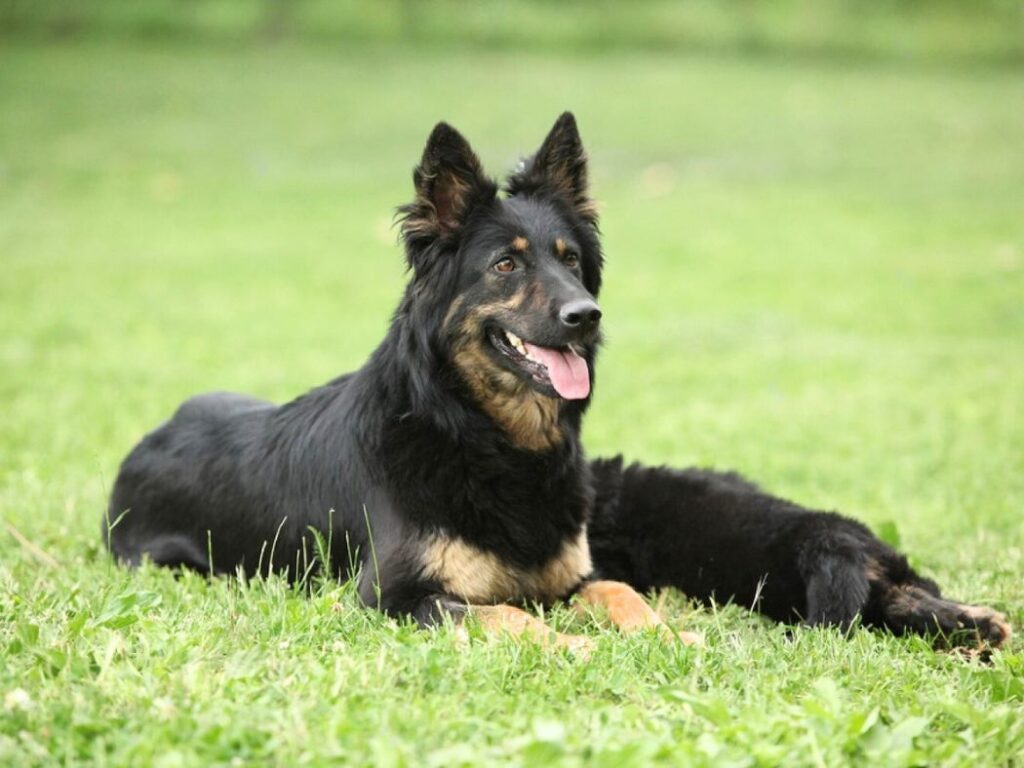
Yes, it is possible for two black and tan German Shepherds to produce a bi-color pup.
This is because the bi-color gene is recessive, meaning that it can be carried by dogs without being visibly expressed in their coat color.
To produce a bi-color puppy, both parents must carry at least one copy of the bi-color gene.
If each parent contributes a copy of the bi-color gene to the offspring, then the puppy will have a bi-color coat.
However, if one or both parents do not carry the bi-color gene, then it is impossible for them to produce a bi-color puppy, regardless of their own coat color.
It’s important to note that genetics can be complex, and there are many different variations and combinations that can influence the coat color of a German Shepherd puppy.
The Other German Shepherd Colors
Black
Black German Shepherds are popular due to their striking and sleek black coat color. This color is determined by dominant genes and is the most common color in German Shepherds.
Despite their beautiful coloring, black German Shepherds are prone to health problems, particularly issues with their eyes and skin.
Gray
Gray German Shepherds are another popular color type. Their gray color is caused by dominant genes and can vary in hue, from a light silvery gray to a darker charcoal shade.
Gray German Shepherds often have amber eyes, which add to their striking appearance.
Sable
Sable German Shepherds are dogs with unique coloring, with patches of darker and lighter fur covering their whole body.
Sable coloring is determined by a recessive gene, which makes sable dogs more rare. Sable
German Shepherds are often seen in working lines due to their high energy and work drive.
Black and Tan
Black and tan German Shepherds have a striking appearance with their black body and tan fur around their eyes, on their legs, and under their tail.
This color type is determined by dominant genes and is common in show lines.
Red and Black
Red and black German Shepherds have a stunning red hue on their body, with black fur on their back and tail.
This color type is determined by dominant genes and is common in both show and working lines.
Black and Silver
Black and silver German Shepherds are another striking color type, with a black body and silver fur on their legs, chest, and under their tail.
This color type is determined by dominant genes.
Liver
Liver German Shepherds have a unique coloring with a rich brown color on their body. This color type is determined by recessive genes and is relatively rare in the breed.
Rare GSD Coat Colors
While German Shepherds come in a wide range of colors, some are rarer than others due to the genetics involved in producing them. Here are some of the rare colors of GSDs:
White
White German Shepherd is a rare color variation in the breed. They have a pure white coat and can have either blue or brown eyes, or a combination of both.
The white coloring is caused by a recessive gene that is less common in the breed.
Despite their striking appearance, white GSD dogs are not recognized by some kennel clubs and are not permitted to compete in certain shows or competitions.
Panda German Shepherds
These dogs have a unique black and white coat pattern, with black patches over white fur. Panda coloring is caused by a recessive gene and is relatively rare.
Cream German Shepherds
These dogs have a creamy white coat color that is caused by a recessive gene. They are not as rare as some other colors, but they are less common than the standard black and tan coloring.
Blue
Blue German Shepherds have a unique hue that ranges from a dark steel blue to a light blue-gray color. This coloring is caused by recessive genes and is relatively rare in the breed.
Isabella German Shepherd
An Isabella German Shepherd is a variation of the German Shepherd breed known for its rare and distinctive coat color. Instead of the traditional black and tan or sable coloration, Isabella German Shepherds have a dilute liver coloration. This unique coat color is often described as a pale or silverish brown, with lighter markings on the face, chest, and paws.
Conclusion
In conclusion, the bi-color German Shepherd is a unique and striking variation of the breed that can make excellent pets for the right owner.
They are loyal, intelligent, and protective, and their distinctive black and tan markings make them stand out from other German Shepherds.
If you’re considering getting a bi-color German Shepherd, it’s important to do your research and find a reputable breeder who prioritizes the health and well-being of their dogs.
By providing your bi-color German Shepherd with a loving home, proper care, and plenty of opportunities to learn and grow, you can enjoy a rewarding and fulfilling relationship with your furry companion for many years to come.
Frequently Asked Questions (FAQs)
What is a bi-color German Shepherd?
A bi-color German Shepherd is a type of German Shepherd with a black coat and tan markings on the legs, chest, and face. The tan markings are usually a lighter shade than the traditional black and tan German Shepherd.
Are bi-color German Shepherds good family dogs?
Yes, bi-color German Shepherds can make excellent family dogs. They are loyal, intelligent, and protective, and they have a strong desire to please their owners. However, like all dogs, proper training and socialization are essential to ensure they are well-behaved and get along well with children and other pets.
Can bi-color German Shepherds be used as working dogs?
Yes, bi-color German Shepherds can be used as working dogs, just like other color variations of the breed. They are often trained as police dogs, search and rescue dogs, and therapy dogs, among other roles.
How long do bi-color German Shepherds live?
On average, bi-color German Shepherds live between 9 and 13 years, depending on their overall health and lifestyle. (Source)

